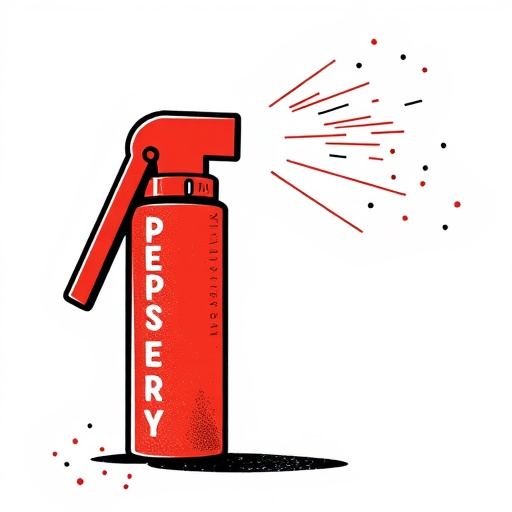In low-visibility conditions, like nighttime riots or enclosed spaces, traditional riot control fails. Low light pepper spray tactics use oleoresin capsicum to quickly incapacitate individuals, minimizing harm and escalation risks. With proper training, officers can deploy accurately in challenging visual conditions, making it an indispensable tool for public safety during riots. Specialized dispensers with advanced illumination systems enhance targeting accuracy in dark or smoky environments, integrating thermal imaging and infrared technology. Regular equipment maintenance and debriefings ensure team proficiency, transforming riot control towards non-lethal methods for de-escalation and injury minimization.
“In scenarios where crowd control becomes a complex challenge, especially in low light conditions, the inflammatory riot control spray dispenser plays a pivotal role. This versatile tool, known for its effectiveness in disrupting and dispersing unruly gatherings, has seen tactical advancements, particularly in pepper spray formulations designed for optimal performance during low-light encounters. Understanding the right dispensing tactics and targeted applications can significantly enhance public safety while navigating chaotic situations.”
- Low Light Conditions: Pepper Spray's Role
- Dispensing Tactics: Effective Strategies
- Targeted Applications: When to Deploy
- Safety Considerations: Training and Equipment
- Revolutionizing Riot Control: Future Technologies
Low Light Conditions: Pepper Spray's Role
In low light conditions, such as during nighttime protests or indoor incidents, traditional riot control methods may become less effective. This is where low light pepper spray tactics come into play. Pepper spray remains a key tool in these scenarios due to its ability to quickly incapacitate individuals, even in dimly lit environments. Its active ingredients, like oleoresin capsicum, cause intense irritation and temporary blindness, making it difficult for suspects or rioters to continue their activities.
The effectiveness of low light pepper spray is amplified by its non-lethal nature, allowing law enforcement to control crowds without causing permanent harm. This ensures a swift resolution while minimizing the risk of escalation. With proper training, officers can deploy these devices accurately even in challenging visual conditions, making them invaluable assets for maintaining public safety during riotous situations or when flashlights and other visible light sources are not readily available.
Dispensing Tactics: Effective Strategies
In low light conditions, such as during nighttime riots or in enclosed spaces, effective riot control requires specific tactical approaches. One key tool for law enforcement and security personnel is low light pepper spray tactics. These strategies involve precise and targeted dispensing to maximize impact while minimizing off-target effects. For instance, using specialized equipment like infrared (IR) scanners can help identify and isolate individuals within dark or obscured areas, enabling more accurate spraying.
Tactical experts recommend employing a “distract and engage” method where pepper spray is used not only to disable but also to create confusion among rioters. This involves quick bursts of spray delivered at strategic points, such as entryways or choke points, to disrupt the crowd’s momentum. Additionally, training in low light conditions ensures that officers can accurately assess and respond to dynamic situations, making use of reflective surfaces and lighting techniques to enhance visibility without drawing unnecessary attention.
Targeted Applications: When to Deploy
In low light environments, such as during night demonstrations or in enclosed spaces, conventional riot control methods may become less effective. Here, low light pepper spray tactics prove invaluable. The inflammatory riot control spray dispenser is designed to disrupt and disperse crowds in situations where visibility is limited. Its precision-aimed stream delivers a powerful yet controlled dose of pepper spray, ensuring the safety of both law enforcement officers and bystanders.
Deploying this device requires strategic consideration. It is most effective when used as a last resort, when other de-escalation methods have failed or are impracticable. Trained personnel should employ it from safe distances, aiming for facial areas to maximize disruption while minimizing risk of permanent injury. The strategic use of low light pepper spray tactics can help maintain public safety and law enforcement integrity during challenging crowd control scenarios.
Safety Considerations: Training and Equipment
Effective riot control requires a well-trained and equipped team. When it comes to low light conditions, such as night time protests or indoor disturbances, specialized tactics become essential. Training should include scenarios that mimic real-world situations, focusing on safe deployment of pepper spray dispensers. Officers must learn to accurately assess the distance and angle for optimal target coverage while minimizing collateral damage.
The equipment itself plays a crucial role in safety. Riot control officers should be issued high-quality, durable low light pepper spray devices designed for quick and reliable activation. Regular maintenance and debriefings on equipment usage are vital to ensure every team member is comfortable with the dispenser’s mechanics, particularly in challenging environments where precise timing and control can prevent accidental discharge or inadequate protection.
Revolutionizing Riot Control: Future Technologies
The future of riot control is here, and it involves innovative technologies that offer safer and more effective solutions for law enforcement agencies worldwide. One such game-changer is the development of low light pepper spray tactics, designed to disrupt and dissipate crowds in challenging lighting conditions. These advanced dispensers are equipped with specialized illumination systems, enabling precise targeting even in dark or smoky environments.
By integrating thermal imaging and infrared technology, officers can now effectively deploy pepper spray with enhanced accuracy, ensuring minimal impact on bystanders and maximizing crowd control. This strategic shift towards more sophisticated tools reflects a growing emphasis on non-lethal methods, aiming to de-escalate tensions and minimize injuries during high-risk situations.
Low light conditions pose unique challenges for riot control, but pepper spray remains a pivotal tool. Mastering specialized dispensing tactics, such as those discussed in this article, ensures its effective deployment during night-time or enclosed space incidents. When used strategically, low light pepper spray can disrupt and disperse rioters safely, making it a valuable addition to any law enforcement arsenal. As technology advances, future innovations in riot control will further enhance these capabilities, revolutionizing how we manage public disorder.
